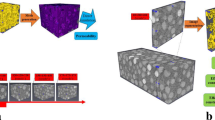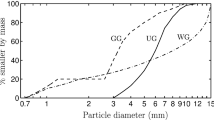Abstract
The hydraulic conductivity of three-dimensional artificial two-phase (fluid phase and solid phase) models with varying solid clustering sizes are evaluated to explore the effect of phase clustering, using low-order probability functions. The original random and heterogeneous microstructure models are made by placing randomly dispersed voxels with varying clustering sizes and the same porosity. The two-point correlation and lineal-path functions are applied to extract characteristics of phase clustering. The reconstructed models whose low-order probability functions are analogous to the original models are then made by a stochastic optimization process. This process allows one to generate equivalent reconstructed models to the original microstructure. The hydraulic conductivity values of both original and reconstructed models along three perpendicular directions are evaluated by solving Navier-Stoke’s equation and averaging local velocity values of fluids with the aid of finite element scheme. Results are analyzed to evaluate the applicability of reconstruction approach depending on the phase clustering. The fluid flow through porous media is further examined with the observation of flow resistance and percolation path. The effects of anisotropy of the fluid phase are also discussed to explore the applicability of stochastic optimization process. It is concluded that the low-order probabilistic functions provide an efficient tool to reconstruct three dimensional microstructures up to certain degree of clustering sizes and to simulate the flow behavior in porous media.
Similar content being viewed by others
References
Adler, P. M., Jacquin, C. G., and Quiblier, J. A. (1990). “Flow in simulated porous media.” International Journal of Multiphase Flow, Elsevier, Vol. 16, No. 4, pp. 691–712.
Bakke, S. and Øren, P.-E. (1997). “3-D pore scale modelling of sandstones and flow simulations in the pore networks.” SPE Journal, OnePetro, Vol. 2, No. 2, pp. 136–149.
Bosl, W. J., Dvorkin, J., and Nur, A. (1998). “A study of porosity and permeability using a Lattice-Boltzmann simulation.” Geophysical Research Letters, AGU, Vol. 25, No. 9, pp. 1475–1478.
Bryant, S. and Blunt, M. (1992). “Prediction of relative permeability in simple porous media.” Physical Review A, APS Physics, Vol. 46, No. 4, pp. 2004–2011.
Chung, S.-Y. and Han, T.-S. (2010). “Reconstruction of random two-phase polycrystalline solids using low-order probability functions and evaluation of mechanical behavior.” Computational Materials Science, Elsevier, Vol. 49, No. 4, pp. 705–719.
Cinlar, E. and Torquato, S. (1995). “Exact determination of the two-point cluster function for one-dimentional continuum percolation.” Journal of Statistical Physics, Springer, Vol. 78, Nos. 3–4, pp. 827–839.
Corson, P. B. (1974a). “Correlation functions for predicting properties of heterogeneous materials. I. Experimental measurement of spatial correlation functions in multiphase solids.” Journal of Applied Physics, APS Physics, Vol. 45, No. 1, pp. 3159–3164.
Corson, P. B. (1974b). “Correlation functions for predicting properties of heterogeneous materials: III. Effective elastic moduli of twophase solids.” Journal of Applied Physics, APS Physics, Vol. 45,No. 1, pp. 3171–3179.
Cule, D. and Torquato, S. (1999). “Generating random media from limited microstructural information via stochastic optimization.” Journal of Applied Physics, APS Physics, Vol. 86, No. 6, pp. 3428–3437.
Daian, J.-F., Fernandes, C. P., Philippi, P. C., and Bellini da Cunha Neto, J. A. (2004). “3D reconstitution of porous media from image processing data using a multiscale percolation system.” Journal of Petroleum Science and Engineering, Elsevier, Vol. 42, No. 1, pp. 15–28.
Dechter, R. and Pearl, J. (1985). “Generalized best-first search strategies and the optimality of A*.” Journal of The Association for Computing Machinery, ACM, Vol. 32, No. 3, pp. 505–536.
Garboczi, E. J., Snyder, K. A., Douglas, J. K., and Thorpe, M. F. (1995). “Geometrical percolation threshold of overlapping ellipsoids.” Physical Review E, APS Physics, Vol. 52, No. 1, pp. 819–828.
Gokhale, A., Tewari, A., and Garmestani, H. (2005). “Constraints on microstructural two-point correlation functions.” Scripta Materialia, Elsevier, Vol. 53, No. 8, pp. 989–993.
Hart, P. E. and Nilson, N. J. (1968). “A formal basis for the heuristic determination of minimum cost paths.” IEEE Transcactions of Systems Science and Cybernetics, IEEE, Vol. 4, No. 2, pp. 100–107.
Kumar, H., Briant, C. L., and Curtin, W. A. (2006). “Using microstructure reconstruction to model mechanical behavior in complex microstructures.” Mechanics of Materials, Elsevier, Vol. 38, No. 8–10, pp. 818–832.
Lu, B. and Torquato, S. (1992). “Lineal-path function for random heterogeneous materials.” Physical Review A, APS Physics, Vol. 45, No. 2, pp. 922–929.
Manwart, C. and Hilfer, R. (1999). “Reconstruction of random media using monte carlo methods.” Physical Review E, APS Physics, Vol. 59, No. 5, pp. 5596–5599.
Montes, J. M., Cuevas, E. G., and Cintas, J. (2007). “Electrical and thermal tortuosity in powder compacts.” Granular Matter, Springer, Vol. 9, No. 6, pp. 401–406.
Narsilio, G., Buzzi, O., Fityus, S., Yun, T. S., and Smith, D. W. (2009). “Upscaling of Navier-Stokes equations in porous media: Theoretical, numerical and experimental approach.” Computers and Geotechnics, Elsevier, Vol. 36, No. 7, pp. 1200–1206.
Narsilio, G., Kress, J., and Yun, T. S. (2010). “Characterisation of conduction phenomena in soils at the particle-scale: Finite element analyses in conjunction with synthetic 3D imaging.” Computers and Geotechnics, Elsevier, Vol. 37, Nos. 7–8, pp. 828–836.
Okabe, H. and Blunt, M. J. (2004). “Prediction of permeability for porous media reconstructed using multiple-point statistics.” Physical Review E, APS physics, Vol. 70, No. 066135, pp. 1–11.
Raab, A. L., Manas-Zloczower, I., and Feke, D. L. (1997). “Influence of structure and interfacial chemistry on the permeability of particle clusters.” Journal of Colloid and Interface Science, Elsevier, Vol. 189, No. 1, pp. 131–136.
Tewari, A., Gokhale, A. M., Spowart, J. E., and Miracle, D. B. (2004). “Quantitative characterization of spatial clustering in three-dimensional microstructures using two-point correlation functions.” Acta Materialia, Elsevier, Vol. 52, No. 2, pp. 307–319.
Torquato, S. (1998). “Morphology and effective properties of disordered heterogeneous media.” International Journal of Solids and Structures, Elsevier, Vol. 35, No. 19, pp. 2385–2406.
Torquato, S. (2002). Random heterogeneous materials, Springer, New York.
Vervoort, R. W. and Cattle, S. R. (2003). “Linking hydraulic conductivity and tortuosity parameters to pore space geometry and pore-size distribution.” Journal of Hydrology, Elsevier, Vol. 272, Nos. 1–4, pp. 36–49.
Werner, E., Siegmund, T., Weinhandl, H., and Fischer, F. D. (1994). “Properties of random polycrystalline two-phase materials.” Applied Mechanics Reviews, ASME, Vol. 47, No. 1, pp. 125–134.
Wu, K., Van Dijke, M. I. J., Couples, G. D., Jiang, Z., Ma, J., Sorbie, K. S., Crawford, J., Young, I., and Zhang, X. (2006). “3D stochastic modelling of heterogeneous porous media — Applications to reservoir rocks.” Transport in Porous Media, Springer, Vol. 65, No. 3, pp. 443–467.
Yeong, C. L. Y. and Torquato, S. (1998). “Reconstructing random media. II. Three-dimensional media from two-dimensional cuts.” Physical Review E, APS Physics, Vol. 58, No. 1, pp. 224–233.
Zaman, E. and Jalali, P. (2010). “On hydraulic permeability of random packs of monodisperse spheres: Direct flow simulations versus correlations.” Physica A, Elsevier, Vol. 389, No. 2, pp. 205–214.
Zaretskiy, Y., Geiger, S., Sorbie, K., and Forster, M. (2010). “Efficient flow and transport simulation in reconstructed 3D pore geometries.” Advances in Water Resources, Elsevier, Vol. 33, No. 12, pp. 1508–1516.
Author information
Authors and Affiliations
Corresponding author
Rights and permissions
About this article
Cite this article
Yun, T.S., Han, TS., Chung, SY. et al. Evaluation of hydraulic conductivity of reconstructed granular media generated using low-order probability functions. KSCE J Civ Eng 18, 132–141 (2014). https://doi.org/10.1007/s12205-013-0381-2
Received:
Revised:
Accepted:
Published:
Issue Date:
DOI: https://doi.org/10.1007/s12205-013-0381-2




